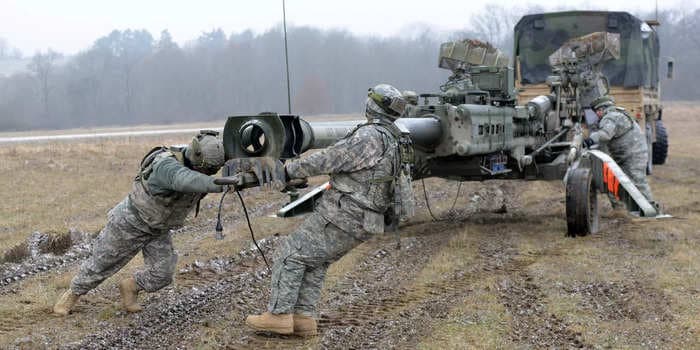Michael Peck

As the Ukraine war has proven, the effectiveness of artillery rests on more than its range or the destructive power of its shells.
The mobility of a howitzer — its capacity to "shoot and scoot" — can make the difference between living to fight another day and being destroyed by the enemy. That's why the US Army is pondering whether hauling guns by truck is still a viable option.
For towed artillery, "10- or 15-minute displacement time is not going to work against a good enemy," Gen. James Rainey, the head of US Army Futures Command, told reporters at the Association of the United States Army's annual conference, held this month in Washington, DC.

US soldiers prepare a M777 howitzer for fire missions at a training area in Germany in January 2020.
The Ukraine war has featured an array of towed and self-propelled artillery in a variety of calibers that have been manufactured by numerous nations. These include the US M109, Russian 2S19, and German PzH 2000 self-propelled howitzers and the US M777, Russian 2A65, and British L119 towed guns.
Both sides are also using numerous weapons to hunt down the other's artillery batteries. These include counter-battery radars to locate hostile guns as soon as they fire and an armada of drones that hover over the battlefield constantly, waiting to pounce on unwary gunners.
New precision-guided shells, such as the US-made, GPS-guided Excalibur, are also being used to destroy an enemy howitzer with one round instead of hoping for a lucky hit with a barrage of unguided shells.
The increasing spread and sophistication of anti-artillery systems is set to feed the long-running debate over the value of towed and self-propelled guns. For most of history — ever since cannon first appeared in the Middle Ages — the big guns were hauled by horses or oxen, which limited their mobility. By the time of the World Wars, trucks could more swiftly tow cannon around the battlefield, though the guns still required time to set up.

US soldiers use a tractor to pull a "Long Tom" artillery gun to the front in Sicily in September 1943.
World War II, however, saw the debut of self-propelled howitzers, often mounted on converted tank chassis. These tracked vehicles could not only keep up with tanks in cross-country movement but also shoot, rapidly relocate, and then shoot again.
Western nations especially tend to base their artillery arsenals on self-propelled guns that resemble lightly armored tanks. Those militaries often earmark towed cannons for airborne and amphibious forces that can't travel with heavy equipment or pass them off to less advanced allies that can't operate mechanized artillery.
Both sides in the towed vs. self-propelled debate make strong arguments. Advocates of self-propelled howitzers point to their superior protection and their ability to rapidly displace after firing. Supporters of towed guns cite their lower cost, lighter weight, and improved setup times. (The US-made M777 is reported to displace and emplace within two to three minutes.)

Ukrainian troops fire an M777 howitzer in the Kharkiv Region in July 2022.
Logistically, towed cannon are less demanding. If a truck hauling a cannon breaks down, another truck can tow it. If the chassis of a self-propelled gun breaks down, the weapon is sidelined.
A sort of hybrid solution is truck-mounted howitzers, such as France's Caesar. These offer self-propelled mobility without the cost, weight, and mechanical complexity, though they also lack armored protection.
In the future, another option is likely to be artillery that can be operated remotely or operate autonomously. "We continue to look at wheeled and robotic solutions to artillery that is towed," Rainey said at the conference.

Extended Range Cannon Artillery program testing at US Army Yuma Proving Ground in November 2018.
Like unmanned aircraft, these robotic artillery systems could be smaller, lighter, and more expendable than human-operated guns. But the US Army's next-generation Extended Range Cannon Artillery is set to essentially be an upgraded M109A7 Paladin with a more powerful gun.
If the war in Ukraine is a guide, artillery will still be the key weapon in future ground combat — and so will counter-battery fire.
Militaries are set to focus on either neutralizing anti-artillery systems or on developing howitzers that are highly mobile or extremely well-protected, though most nations will likely invest in both. But as the war in Ukraine has also shown, there are no silver bullets on or above the battlefield.
No comments:
Post a Comment